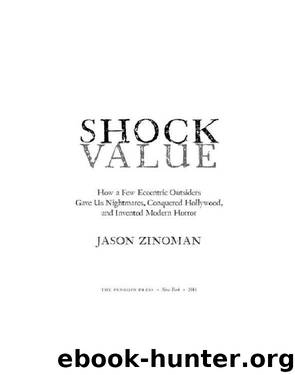Shock Value by Jason Zinoman

Author:Jason Zinoman
Language: eng
Format: mobi, epub
ISBN: 9781101516966
Publisher: Penguin Group USA, Inc.
Published: 2011-06-10T10:00:00+00:00
BY THE SEVENTIES, the werewolf had gone out of fashion in the movies, and the Frankenstein monster grumbled angrily less often than he once did. Zombies were multiplying, and the occasional ghost haunted a creepy house with a squeaky floorboard. But the most compelling monster of the era was the serial killer, a term invented by the FBI in the mid-seventies.
The serial killer became much more prominent in the popular imagination on August 8, 1969, the day that Joan Didion, in The White Album, explained was considered by some to be “the end of the sixties.” As soon as the murders at the house of Roman Polanski were reported, whispers about the director spread through Hollywood. The national press presented him as a bizarre, promiscuous European stranger with a thick accent, long hair, short stature, a taste for violence, and a tragic family history. Most of all, there were those weird movies. “It was a scene as grisly as anything depicted in Polanski’s film explorations of the dark and melancholy corners of the human character” was how Time magazine described the murders.
Early newspaper stories emphasized that Polanski was abroad during the murders but that he was cracking jokes at a Broadway show before a killer was apprehended. Polanski added to the suspicion by visiting the murder site for the first time with a photographer who took shots that were widely publicized. It made a terrible crime look like another act of self-promotion. Law enforcement focused on Polanski as the first suspect in the case, and he was brought in to talk to the police. The investigators asked why his wife would be targeted. At the time, they were searching desperately for some kind of motive. Polanski had a telling suggestion. “The whole crime seems so illogical,” he explained to the detective during a polygraph test. “If I’m looking for a motive, I’d look for something which doesn’t fit your habitual standard, with which you use to work as police, something much more far out.”
He was talking in private to the police, but this was an answer that he could have also delivered to film critics looking to know where future monsters of the horror genre would come from. In the New Horror, clear motives and obvious metaphors were replaced by a more general sense of confusion. The murders of Sharon Tate and her friends were so bizarre and random and spectacular that for many people they almost didn’t seem real. The situation only became murkier when the world learned about Charles Manson. Details trickled out about this other strange little man and his virulent cult, and they didn’t add up to a coherent picture. He was described as a hippie but also as someone who hated hippies, a nihilist and a race warrior, an idiot and a genius, starved for fame and completely indifferent to it. None of these explanations made more sense than Polanski’s original speculation. Manson was simply far out.
By the early seventies, as his multiple insanity trials received blanket press coverage, Manson became an antihero for a segment of the counterculture.
Download
This site does not store any files on its server. We only index and link to content provided by other sites. Please contact the content providers to delete copyright contents if any and email us, we'll remove relevant links or contents immediately.
The Kite Runner by Khaled Hosseini(5083)
Gerald's Game by Stephen King(4582)
Dialogue by Robert McKee(4321)
The Perils of Being Moderately Famous by Soha Ali Khan(4169)
The 101 Dalmatians by Dodie Smith(3453)
Story: Substance, Structure, Style and the Principles of Screenwriting by Robert McKee(3397)
The Pixar Touch by David A. Price(3364)
Confessions of a Video Vixen by Karrine Steffans(3246)
How Music Works by David Byrne(3187)
Fantastic Beasts: The Crimes of Grindelwald by J. K. Rowling(2994)
Harry Potter 4 - Harry Potter and The Goblet of Fire by J.K.Rowling(2990)
Slugfest by Reed Tucker(2939)
The Mental Game of Writing: How to Overcome Obstacles, Stay Creative and Productive, and Free Your Mind for Success by James Scott Bell(2845)
4 - Harry Potter and the Goblet of Fire by J.K. Rowling(2655)
Screenplay: The Foundations of Screenwriting by Syd Field(2574)
The Complete H. P. Lovecraft Reader by H.P. Lovecraft(2514)
Scandals of Classic Hollywood: Sex, Deviance, and Drama from the Golden Age of American Cinema by Anne Helen Petersen(2465)
Wildflower by Drew Barrymore(2443)
Robin by Dave Itzkoff(2383)
